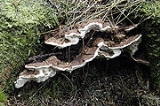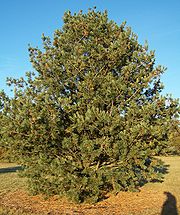
Heterobasidion annosum
Encyclopedia

Bondarzewiaceae
Bondarzewiaceae are a family of fungi in the order Russulales. The type species for both its genus and the family as a whole, Bondarzewia montana, closely resembles members of Polyporales , but has ornamented spores like those of Lactarius or Russula...
. It is considered to be the most economically important forest pathogen in the Northern Hemisphere. Heterobasidion annosum is widespread in forests in the United States and is responsible for the loss of one billion U.S. dollars annually. This fungus has been known by many different names. Commonly, it is also known as annosum root rot. First described by Fries
Elias Magnus Fries
-External links:*, Authors of fungal names, Mushroom, the Journal of Wild Mushrooming.*...
in 1821, it was known by the name Polyporus annosum. Later, it was found to be linked to conifer disease by Hartig in 1874, and was re-named Fomes annosus by H. Karsten. Its current name of Heterobasion annosum was given by Brefeld in 1888. Heterobasidion annosum is one of the most destructive diseases of conifers.
Ecology and Life Cycle

Basidiospore
A basidiospore is a reproductive spore produced by Basidiomycete fungi. Basidiospores typically each contain one haploid nucleus that is the product of meiosis, and they are produced by specialized fungal cells called basidia. In grills under a cap of one common species in the phylum of...
s, the primary infective propagules, are released. These basidiospores are carried long distances by wind currents. They infect trees through damage such as freshly cut stumps. Once on the stump the fungus colonizes and moves into the root via mycelium
Mycelium
thumb|right|Fungal myceliaMycelium is the vegetative part of a fungus, consisting of a mass of branching, thread-like hyphae. The mass of hyphae is sometimes called shiro, especially within the fairy ring fungi. Fungal colonies composed of mycelia are found in soil and on or within many other...
. The Heterobasion annosum moves short distances from the roots of an infected stump through root graphs with other trees. It can also spread through insects that feed on roots.
Since this fungus can not move very far through soil, it relies on tree roots to help it infect neighbouring trees. In these roots, it can grow 0.1–2.0 m per year. This results in a spread of the fungus and disease gaps in the forest. These disease gaps are produced when the trees dies and falls, creating gaps in the forest canopy. These gaps affect the moisture and sunlight available, altering the habitats for plants and animals on the forest floor. Spiniger meineckellus, the name for of the asexual stage of this fungus, is produced on stumps when the conditions are moist, and the conidiospores that are produced will be able to live in the soil for up to ten months. The role of conidiospores is unknown in the infection process and is not thought to be important.
Identification

Basidiocarp
In fungi, a basidiocarp, basidiome or basidioma , is the sporocarp of a basidiomycete, the multicellular structure on which the spore-producing hymenium is borne. Basidiocarps are characteristic of the hymenomycetes; rusts and smuts do not produce such structures...
s, are whitish around the margins, with button shaped pads, and dark brown on the upper surface. This fruiting body is created from mycelium, the mass that forms around the vegetative portion of the a tree body, i.e. that part of the tree with no differentiation like stem, leaves, or in this case roots. Basidiocarps are about 40 cm in diameter and 3.5 cm thick. The lower surface of the fruiting body is made of visible pores that are between 5 mm and 26 mm. Sexual spores are created from the basidiocarps, called basidiospores. Conidiospores occur in the sexual stage and are produced on conidiophores. Conidiospores and basidiospores are both produced by fungus, the latter being more important for infecting the conifers.
Symptoms and signs of disease
Symptoms and signs of fungus disease are often found underground. The H. annosum infections cause an abnormal change in structure in the roots that climbs up to the butt of the tree. More than half the tree may be killed before any symptoms appear to the human eye. Basidiocarps can take up to one and a half or even three years to be visible. This infections causes the trees to have abnormal needle growth, pale yellow barks, and the trees to wither and die. The white rot fungus found in the roots is the sign of telling whether the tree has been affected by H. annosum. The bark changes colors as the stages progress, they go from pale yellow, to a crusty light brown, and finally in its advanced stage it turns white with the signature of Fomes annosus ― a sprinkled streak of black spots. Another sign is the leaking part of the root that causes a compact mass to form between it and the sand.Isolation
There are several ways to isolate Heterobasidion annosum. Water agar could be used with infected host tissue to produce conidiophores which a simple or branched part hypha of a fungus to eliminate heterobasidion annosum. Another way of isolating heterobasidion annosum is by using the thin disks of living sapwood from Picea abies. By cutting the thin disks into petri dishes which is used to culture bacteria and placing them on moist filter paper, this technique allows spores to be captured from the air, and result in the asexual stage of the fungus forming on the disks.Management
Theoretically, a root can be suppressed during all stages of its life cycle. There are three ways of managing Heterobasidion annosum: silvicultural control measures, chemical methods and biological control. Silvicultural control involves planting species with low susceptibility. This could lower the root rot problem and free an infected site from inoculum. A more extreme measure is to remove the inoculum from the infected site. Proper planning and mixture schemes produce a better yield than a pure plantation (i.e. containing only one species). An alternative species could always be used for protection against H. annosum. Chemical methods include prophylactic stump treatment immediately after the infection. This protects the stump by hydrolysis of the compound by the enzyme ureaseUrease
Urease is an enzyme that catalyzes the hydrolysis of urea into carbon dioxide and ammonia. The reaction occurs as follows:In 1926, James Sumner showed that urease is a protein. Urease is found in bacteria, yeast, and several higher plants. The structure of urease was first solved by P.A...
in the living wood tissue, which results in formation of ammonia
Ammonia
Ammonia is a compound of nitrogen and hydrogen with the formula . It is a colourless gas with a characteristic pungent odour. Ammonia contributes significantly to the nutritional needs of terrestrial organisms by serving as a precursor to food and fertilizers. Ammonia, either directly or...
and a rise in pH
PH
In chemistry, pH is a measure of the acidity or basicity of an aqueous solution. Pure water is said to be neutral, with a pH close to 7.0 at . Solutions with a pH less than 7 are said to be acidic and solutions with a pH greater than 7 are basic or alkaline...
to a level that H. annosum at which mycelia are unable to survive. Biological control is another alternative. Currently, a number of fungal species such as Phlebiopsis gigantea, Bjerkandera adusta
Bjerkandera adusta
Bjerkandera adusta, also "White Rot," is a plant pathogen.- External links :* *...
and Fomitopsis pinicola
Fomitopsis pinicola
Fomitopsis pinicola, in English sometimes known as Red Banded Polypore, is a polypore mushroom of the genus Fomitopsis. The species is common throughout the temperate Northern hemisphere. An alternative binomial name is Fomes pinicola....
have been tested on stumps as competitors and antagonists against H. annosum. However, among these, only Phlebiopsis gigantea shows good results of eliminating H. annosum.

